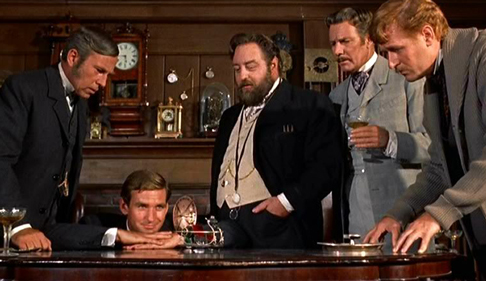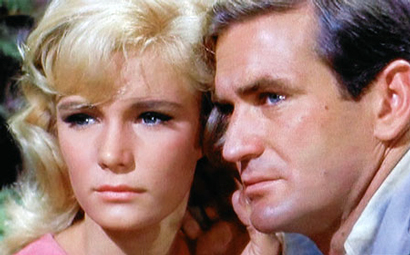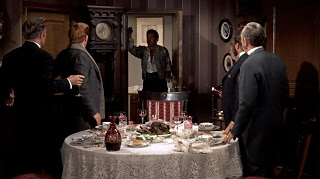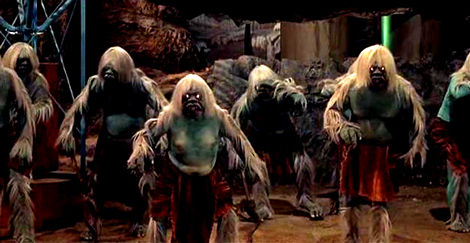Reviewed by Glenn Erickson
1959's Journey to the Center of the Earth began a brief flourish of major studio interest in higher-budget science fiction adventures. Although not lavishly produced, George Pal's 1960 version of the H.G. Wells classic The Time Machine dazzles with a battery of clever special effects. The key the Jules Verne successes was the appeal to a wide audience. An A-class family attraction from the get-go, Pa;l's show gambled that Wells' name would pull in the same crowds as did Walt Disney's major smash 20,000 Leagues Under the Sea.
George Pal was on a roll at MGM. Already famous for his Puppetoon short subjects, he'd inaugurated the science fiction craze ten years earlier with three Technicolor hits. Given the boot from Paramount after the failure of Conquest of Space, he turned his energies away from space fantasy. Pal's MGM hit tom thumb put him back on track with the studio brass.
I met Mr. Pal at the 1976 Filmex screening festival. Just as everyone had claimed he was utterly charming to strangers, and not the sort one might think could survive in Hollywood. His uncomplicated sentimentality and religious nature equipped him well for fairy tale projects like tom thumb, but he was often drawn to dramatic material with complex moral and political ideas. The overemphasis on De Mille-like religious fervor is an uncomfortable fit for Pal's When Worlds Collide, but Pal almost entirely sidesteps the mordant mood of author Charles G. Finney's The Circus of Dr. Lao. Savant finds most of Pal's work to be very satisfying, just the same.

As with the earlier Jules Verne adaptations The Time Machine begins in a period setting, England of 1899. George Wells (Rod Taylor) demonstrates his newly invented time machine, hoping to interest his stuffy friends in the wonder of visiting the future. Disillusioned by their inability to see beyond petty comforts and war profiteering, the pacifistic George bids his peers farewell and takes a trip forward in time, very tentatively at first. Everything he sees is warped by war. His dear friend Filby (Alan Young) dies in WW1. A 1966 war with nuclear satellites effectively ends civilization. George stops far in the future, in the year 802,701. The Earth has become a Garden of Eden. He discovers a strange society of beautiful but passive people called Eloi, none of whom seem to be over twenty years of age. He meets the comely Weena (Yvette Mimieux) but is disenchanted to find that the Eloi have lost all knowledge of independence, curiosity, and chivalry. He then learns that this paradise is actually a human stockyard. The Eloi are pampered and husbanded as a food supply for the subterranean Morlocks, hairy green monsters with snaggle teeth and glowing eyes. Seeking to inspire men of his own time, George instead becomes the warrior-emancipator of a remote future world.
The Time Machine is easily George Pal's best directed movie, and with the exception of The War of the Worlds is his best overall. It was a solid hit in 1960; this ecstatic 8 year-old sat through it twice. Barely heard were the misgivings of sober critics that decried Pal's diluting of Wells' original story. In 1895, the Darwinian idea that Capital and Labor might devolve into separate species of men was intellectually controversial. Wells had used it as a political critique of his times. 1

Pal and screenwriter David Duncan retained H.G. Wells' narrative framing device of the two 1899 dinner parties, but greatly altered the Eloi of the 803rd Millennium. Wells' Eloi are a depressing race of slight and effete midgets that resemble miniature deer on two legs. When trying to communicate with them, the original Time Traveler (he had no given name in the book) has zero luck getting much further than 'hello'. This lack of satisfying human contact simplified Wells' storytelling chore while making his adventure more like a waking nightmare than a journey to a faulty Eden. The events in the book are also more depressing. The Time Traveler has a soft spot for Weena, but as she's only quasi-human, the romantic angle is lacking. Wells' Time Traveler briefly mulls over the idea of becoming an Eloi Emancipator, whereas Pal's George is given a character arc more like Edgar Rice Burroughs' John Carter of Mars. He begins as a typical English tourist in a Third World land, shocked by everything he sees and having a tough time coping with anything un-English. Within 24 hours he's spearheading an Eloi revolution. It's a good thing that George returns to the future, as the Eloi are apparently incapable of doing anything for themselves.
Unlike screenwriter Duncan's revolutionary hero, Wells' original time tripper finds no uplifting moral lessons, just a despairing future he cannot alter. In the movie, kitchen matches and fire re-ignite the spark of basic civilized values. In the book, the Time Traveler's matches accidentally burn down the forest, killing an unknown number of Morlocks and Eloi.
Taken by itself, most of Pal's The Time Machine is dead on the mark, entertainment-wise. 1899 is neatly sketched with just a few scenes. His actors have clear parts to play, and the explanation of the Fourth Dimension communicates well even to children. Alan Young is solid as Pal's moral anchor, affecting an endearing if hammy Scots accent. Four years earlier, the under-appreciated Rod Taylor had a featured role in a space movie involving involuntary time travel, World Without End. He shows considerable charisma as Pal's hero, becoming a rare case of an actor helped rather than hindered by being cast in a science fiction movie. Yvette Mimieux was only seventeen during filming. Twelve years later I served her popcorn at the National Theater in Westwood. It's a pleasant memory; her perfect eyes and complexion hadn't dimmed one bit.

Pal did a good job matching the appropriate effects to his story, given the lowly status of film effects at the time. Unlike some science fiction pictures, The Time Machine required something new and creative in almost every scene. The big studios always preferred the control factor of keeping the work on the lot, but by 1960 MGM's crafts and effects departments had been whittled down to nearly nothing. The most the studio could offer was the back lot and giant warehouses of props and costumes. Pal re-used items from inventory -- 1966 civil defense costumes are from Forbidden Planet -- but contracted most of his visual effects to eager outside vendors.
A literary discovery?
In my review of the 2000 DVD release of The Time Machine, I explained a discovery I made back in 1979 while reading an uncut copy of The Time Machine. I've yet to read a mention of this from any other source.
As literary science fiction The Time Machine doesn't overly complicate its story of a man traveling into the far future, and then returning to his own time. Although heroes like Rip Van Winkle were time travelers more or less, Wells' book introduced readers to abstract concepts that, it is usually assumed, were later developed to a higher level of complexity by other authors. At least by Junior High, we school kids were well aware of time travel conundrums. The big question was, "If you go back in time and kill your other self, will you disappear, because then you can't have lived into the future to go back in time?" This has pretty much replaced the great chicken-egg debate as the classic schoolyard argument-starter.
Because the book's Time Traveler never returns to 1900, Filby (the narrator) concludes that he must have met some calamity in the past or the future, and the story ends in a bitter question mark. Pal and Duncan soften the sadness with their 'which three books?' gimmick, which works well enough in context. But, although Filby didn't realize it, in the book the Time Traveler did return.

The Silent Man.
The guests are all identified at the first dinner party. At the second dinner party Filby makes brief note of a guest identified only as The Silent Man. This bearded, older fellow is assumed to be someone else's tag-along guest, but Filby does not know whose. The Silent Man (pointedly capitalized each time he is mentioned) takes no part in the heated discussions, and simply observes what happens. He stares at The Time Traveler, and at one point pours him a glass of wine. He never says a word. When the dinner party breaks up, The Silent Man slips away, the perfect party crasher.
The Silent Man is obviously the Time Traveler himself, returned at an advanced age. Older but perhaps wiser, he's returned to contemplate his younger self. His motive can only be guessed at, and it is easy to read anything one wants into his blankness. Perhaps the Time Traveler had many adventures, and before dying wanted to reflect on his origins. Maybe he's been a tourist throughout the ages, taking pains to be a fly on the wall at all times. After his soul-crushing trip to the twilight of existence, the future with the empty beach and the giant crabs, perhaps he finds comfort just being an anonymous man among other men.
Am I in error by thinking this is something new to report? It alters my impression of the book and forces a reevaluation of Wells. The author now seems to have been perfectly capable of conceiving of Phillip K. Dick time puzzles, even back in 1895. Perhaps Wells thought his Victorian audience wasn't ready for such complications.
That's the Savant literature lesson for the day -- The Time Machine has subtleties for which Wells was rarely given credit. If you make a lunge for the book to check this out, be forewarned that some copies have it and some don't. The original book had several lives, serialized in periodicals and under separate cover; The Silent Man may have been edited out for later versions. Or he may have been an unauthorized addition by a 'creative' editor in a subsequent printing -- like the confusion of Captain Nemo as 'Count Dakkar' in differing editions of 20,000 Leagues Under the Sea.
Warner Home Video's Blu-ray of The Time Machine is a good HD encoding of this favorite filmed in Eastmancolor and processed by the Metrocolor Labs. It looks as though the video colorists have done quite a bit of work extracting better hues out of somewhat faded elements. In general all looks fine. The effects scenes appear to have been filmed on different stock that held up better, while the only shots that actually suffer are original optical blow-ups, to pull a close-up out of a medium shot, etc.
I've always been bothered by the brief exterior scene in which George bids farewell to his friends after his afternoon demonstration of the little time machine model. 'Happy Christmas' revelers ride by in a coach. It's wintertime in London a week before Christmas and the time is 6pm, so it should be turning dark. Yet the exterior is timed for bright high noon, which makes London look like Culver City, California.

The other timing issues are probably related to the loss of density in faded film materials. The underground caves of the Morlocks were much darker away from the direct light, and the painted backdrop at the back of the set wasn't as red. I'm guessing that the (very good) transfer had to deal with a negative with faded blues.
One aspect of the show that isn't often praised is Russell Garcia's beautiful music score, which accentuates the sense of daring and danger in George Wells' journey into the future. 2 Even more memorable are Garcia's delicate melodies that remind us that George is from the 19th century. It seems appropriate for George Pal's personality that The Time Machine ends on a quiet, sweet note.
The major extra is still the 50-minute TV documentary, The Time Machine: The Journey Back that was included on the earlier DVD. The 1993 production is a valentine to film craftsmen that genuinely love their work. After an overview of George Pal and the movie, the show tells the tale of The Time Machine's title prop from construction, to auction, to its rediscovery in a thrift store and reconstruction by some dedicated effects people, including the brilliant fabricator-artist Tom Scherman. The haste and bluntness of studio work can be judged by the fact that as soon as the throne-like Time Machine prop had finished shooting, it was sawed apart to film inserts of its control panel. Nowadays there'd be three sturdy props with breakaway variations; the original Time Machine was a delicate construction that barely lasted through shooting. Nice that it doesn't look it.
The docu features the noted monster-maker and prop collector Bob Burns, but also details other effects processes. At one point Gene Warren talks about a talented painter whose canvasses were animated as he painted them, to produce images of foliage growing and such. If I'm not mistaken, some close-ups of leaves and apples growing during this explanation is really replacement animation of Pal's familiar Puppetoon variety. Later on the docu shows views of entire landscapes changing with the seasons, and an Eloi dome being built, which Savant thinks correctly illustrates the work of the skilled painter.
The Journey Back includes a newly produced scene between Alan Young and Rod Taylor reprising their characters. It starts well but doesn't add up to much beyond making us wonder why sequels to The Time Machine were never made. With both Rod Tayor and Yvette Mimieux still with us, a sequel would seem a natural, especially in the early '70s when Pal was in a slump and Fox was mining annual pay dirt with its Planet of the Apes series. Pal apparently floated a number of scripts, but nothing ever came about. One reason for this might have been the notion that shows like the Ape series and television's The Time Tunnel had left Pal's simple 'go there - come back' plotting far behind. Science Fiction readers, especially those hip to the mind-warping puzzle tales of (the great, wonderful) Phillip K. Dick books like Ubik and The Man in the High Castle also probably felt that Wells' original story was a great concept that time had made obsolete. It remained for Zemeckis and Gale's clever Back to the Future movies to rediscover and mine the time travel concept for general audiences.
A flat transfer of an excellent original trailer is included as well. The packaging is fairly plain-wrap, with a disc cover design that looks like some artwork was pulled out of a scanner too soon. But the show inside is classic Sci-fi filmmaking at its best.
On a scale of Excellent, Good, Fair, and Poor,
The Time Machine Blu-ray rates:
Movie: Excellent
Video: Excellent -
Sound: Excellent
Supplements: 50-minute making-of doc about the Time Machine prop.
Deaf and Hearing Impaired Friendly?
YES; Subtitles: English, many others
Packaging: Keep case
Reviewed: June 27, 2014
Footnotes:
1. With the political climate now so ideologically polarized, 'mankind' in America seems well on its way to a different kind of Eloi-versus-Morlocks schism. But there are too many issues involved. If I begin to transform into a Morlock, I'll have more to say on the subject.
Return
2. Added thought -- shouldn't George have checked to make sure his machine functioned in reverse before jaunting ahead 802,000 years into the future? And wouldn't it have been wise to take a few tools and spare parts along with him?
Return

Text © Copyright 2014 Glenn Erickson
See more exclusive reviews on the Savant Main Page.
Reviews on the Savant main site have additional credits information and are often updated and annotated with reader input and graphics.
T'was Ever Thus.
Return to Top of Page
|

